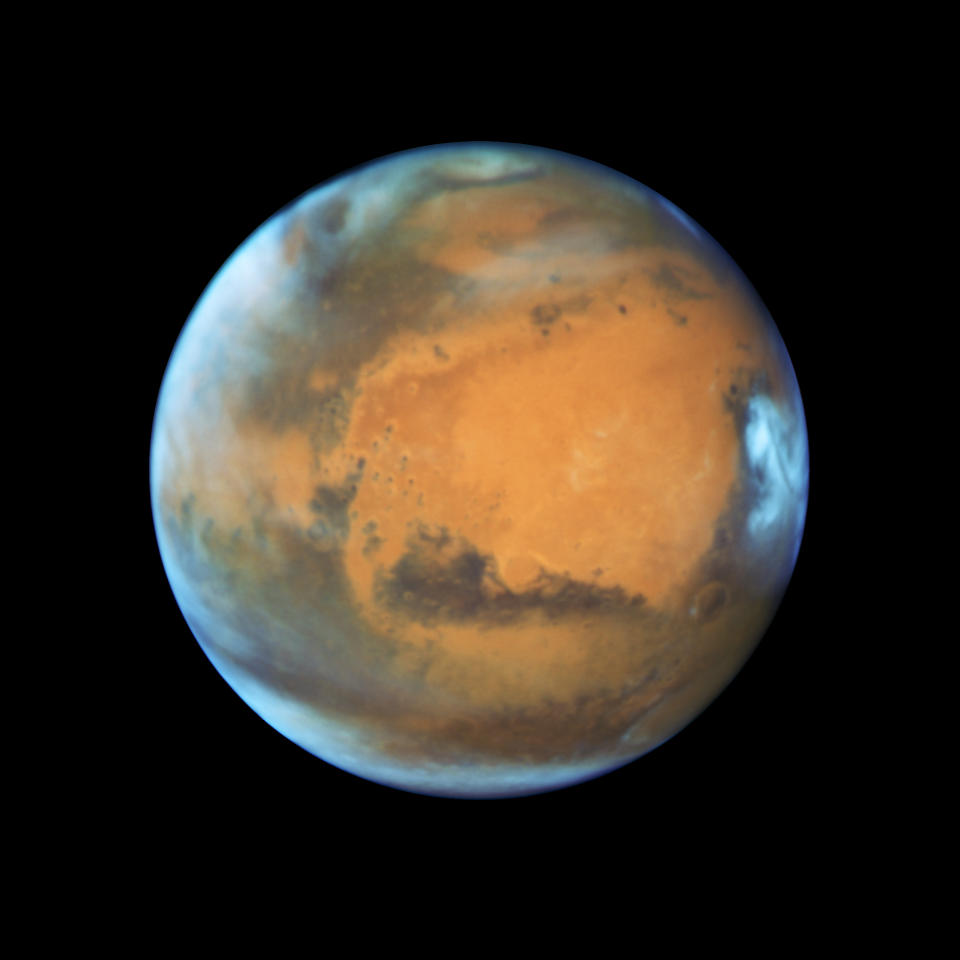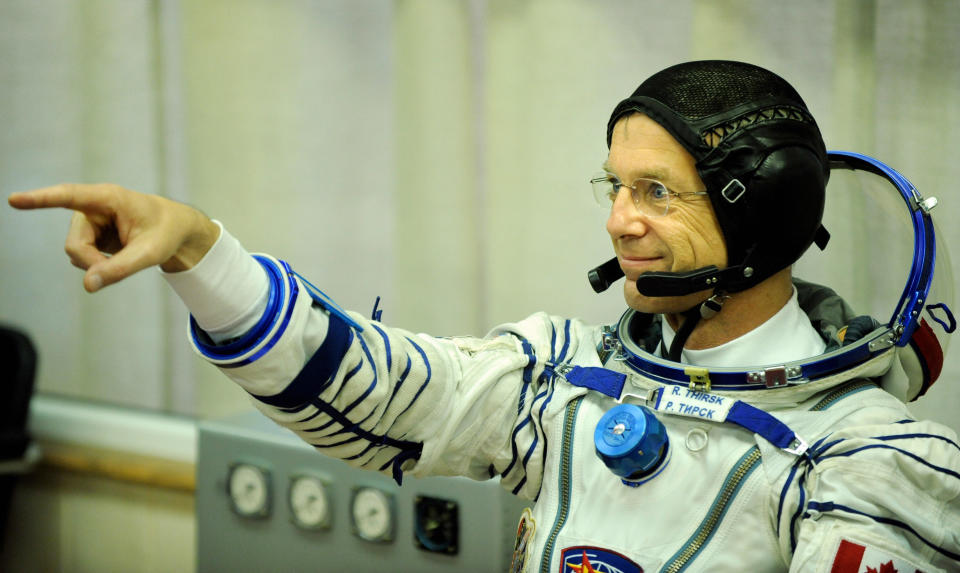Canada poised to play critical role on future Mars mission

Last December, the Canadian Space Agency put up a job posting and said there was only one man on Earth who could possibly meet the requirements: Dr. Robert Thirsk.
They described the Canadian astronaut as uniquely qualified for the position, thanks to his background as a medical doctor and his substantial time spent in space: a total of nearly 205 days between his time on the International Space Station and his 17-day stint aboard Space Shuttle Columbia.
Yahoo Canada reached out to Dr. Thirsk earlier this year to discuss the role, Canada’s future when it comes to space exploration and how medical research for deep space could actually transform the lives of Canadians.
NASA recently met with stakeholders in Ottawa to seek Canada’s involvement in the first steps for sending humans to Mars. What role do you think Canada will play in this next phase of space exploration?
You need to talk to a politician, not an astronaut, to get an answer to that question. Right now, the Canadian government is considering the future of space program, and that very question you just asked is being considered right now. I think it’s going to take a few more weeks, or a few more months, before the Canadian government is ready to address that.
But it is true that NASA has been talking to the Canadian Space Agency and other international space agencies about participation in the next phase of human space exploration to deep space — to an asteroid, to Mars — and the Canadian government is considering whether or not we can be involved.
Do you see Canada having involvement in future space missions?
We have great capability in Canada. The first area of course is robotics. Canada has excelled with space robotics with the Canadarm for the space shuttle, and the Canadarm2 and other robotics aboard the International Space Station. They’ve played small but extremely critical roles in both of those programs. Canadian industry and Canadian researchers are well poised to contribute robotics to deep space exploration.
The plan is by 2022, international space agencies led by NASA will begin to build a lunar gateway, a mini space station around the Moon. There is a need for robotics on the outside of that mini space station, as well as inside, and Canada has the technical capabilities and experience to contribute that. But as I mentioned, the Canadian government has to decide whether or not we can do that.
NASA has also asked Canada to consider providing astronaut health care for these upcoming deep space missions. So we’re looking.
While we wait for the government to decide the future of Canada’s space program, we’re working in parallel to assess whether or not Canada has the health-care expertise and technology, and the social benefit to continue astronaut health care on deep-space missions.
I think the answer will be yes, but again we can’t move forward until the Canadian government makes a decision.

When you’re talking about astronaut health care, what are some of the specific needs you’re looking into to provide the best care for astronauts?
I flew aboard space shuttle and also aboard the International Space Station and I have a background as a medical doctor, but if there are any serious medical issues that develop aboard the space station, the medical team on the ground takes over and helps to provide care for the ill crew member. In the worst situation, in which a crew member needs to be brought home, that crew member is deorbited and advanced treatment occurs on some hospital centre on Earth.
That’s no longer going to be possible for deep-space missions because of the large distance that’s involved. For example, Mars is 400,000,000 km away from Earth. If there is a medical problem, the ground cannot support the astronauts on Mars. If you were a Mars astronaut and I was at mission control on Earth, and you called me to say that there was a medical emergency on board the Mars vehicle, I wouldn’t hear you for 20 minutes, and you wouldn’t hear me respond for another 20 minutes.
With that big time lag because of the distance, we need to have more autonomous health care aboard a deep-space vehicle. So autonomous medical operations are going to be something we have to develop. We have no experience with that right now. We’re also going to have to develop more of what we call a patient-centric model of health care, meaning the patient is going to have to take some responsibility for managing and monitoring their own health care. We’re also going to have to have something called point-of-care laboratory support, which means that we can’t save up our blood specimens and our urine specimens and send them down to Earth for analysis, we need to have the Mars astronauts do it themselves.
This is all new, it’s a model of medicine that we haven’t done before in space. Canada is leading the world in a lot of these areas — autonomous health care, patient-centric medicine, point-of-care medicine — in order to provide care to Canadians that live in remote parts of the country.
If we do invest in deep-space health care, there could be benefits for delivering health care to Canadians who live in remote regions and even for geriatric patients, who we’d like to leave at home rather than bring them into a tertiary-care centre.
It sounds similar to some of the medical care you hear about for people at the South Pole, is it similar to that?
Yes, and also northern Canada as well. Think of some of the northern communities in Canada — Resolute, Cambridge Bay, Pangnirtung — these are centres that may not have a physician there, may not have a large emergency room, but they do have health-care practitioners, perhaps a nurse practitioner there, who is doing the best that they can using virtual or tele-medical health capabilities to provide care to northerners.
Now the quality of care that we’re able to provide to northerners is not the same kind of care that you or I living in an urban centre will receive, and that’s not adequate. We need to make sure that the quality of care for all Canadians, no matter where they are, is superb. I think by investing in deep-space health-care protocols (and) technology, I think that we can do two things at once; we can participate in international space exploration and we can also improve the quality of health care delivered to remote Canadians.
What are the next steps that will have to happen in order for us to send people to Mars?
I don’t think Mars is going to be the next destination, I think that the Moon is likely to be the next destination, and that’s because of a number of technologies that we need to develop before we have the confidence or before we have reliable systems to go to Mars.
Some of the issues that we need to address are going to be cargo transportation, surface mobility — rovers and astronaut mobility on the surface of a deep space body, robotic space exploration, human space exploration. We have to develop precision landing capabilities,. We have to address some safety enhancements and power enhancements to rocket engines. We have to develop new escape technology — you and I already talked about some of the health-care delivery challenges there but there’s also environmental control and life support system technology that need to be developed before we’re confident about going to Mars.
The Moon is only three days away. So what we’re going to see is that in 2022, the international community is going to start launching components for this mini space station that I mentioned to you. First element is going to be a power and propulsion element being launched in 2022, and then in 2023 a habitation module will be launched. Over a period of several years, this mini space station near the Moon called the lunar gateway will be built up. Once we have habitation capabilities there, crews will venture from Earth to the Moon for, say, 30- to 60-day missions at a time. There will also be possible missions by astronauts from that gateway down to the surface of the Moon to develop all these technologies. We need to develop that capability before we have the capability to go to Mars.
We are not going to go to Mars directly, it’s too big a step for us to take. The baby step in between will be this mini space station at the Moon. Possibly after that, a visit to an asteroid, and then probably by about 2033, we’ll be sending the first mission to Mars.
A good way to think about it is that the Mars astronauts are alive today, and they are currently in high school or university. It’s real, it’s coming close, and we need to make sure we properly prepare the technology and protocols for these future astronauts so that their missions will be successful and safe.
The CSA put out a job description in late December and they said you’re the only person on Earth qualified for the job. Does that mean it’s something you’ll be pursuing, helming Canada’s efforts to get to Mars?
Last year, I had a similar contract with Canadian Space Agency, and I was asked to answer the question whether or not Canada had the interest and the capability to play a leadership role in deep space health care. My group already provided our report to the Canadian Space Agency and the answer was a resounding yes.
Now the CSA has said that they welcome that report from us and they want to know a little bit more about what it would take for Canada to invest in leadership in deep-space health care and what the social benefit would be to Canadians.
This will be a second contract. It will not just be me, it will also include Dave Williams, who is another Canadian astronaut who will play a leadership role in this next phase, and also several other health-care experts in Canada to really look at seriously. If this is something Canada is going to do, we have to identify what the timeline is, what technologies are going to be required, what benefits to the Canadian taxpayer would be and what the benefits would be to the Canadian health-care system.
I will answer the contract offer with a “yes” and I’m eager to get started as fast as possible.
In the area of medical technology capability, I’m kind of a visionary person, I think that Canada has the ability to play a leadership role here, and some of the noteworthy areas of strength in Canada in health care are in areas of medical diagnostics, artificial intelligence. In Edmonton, Toronto and Montreal, we have global centres of excellence for artificial intelligence, surgical robotics and training capabilities, as well. I think there are certain niche areas of expertise in Canada that few other nations can claim. These are going to be the foundations upon which we can potentially build this deep space health-care initiative.
This interview has been edited for clarity.

 Yahoo Sport
Yahoo Sport 







































